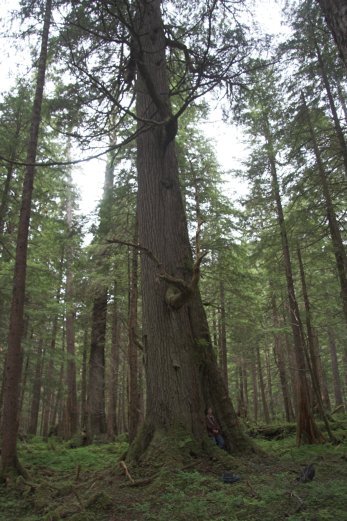

 Armillarias seem to be one of the mushrooms that are found toward the end of the fall mushroom season. Not that they don't fruit earlier in the year, but that they seem to keep fruiting when most other species have given it up for the year. Although they fruit abundantly and don't get as gushy as say a Russula would with the heavy rains of October, individually they don't seem to hold up as long as other species, e.g. Golden chanterelles. The Armillarias seem to get mushy in a couple of weeks or less, while the Golden chanterelles seem to last for upwards of two months (it was very hard not picking the one near the trail to the house. I'm happy to report that the neighbors also resisted in the interest of learning just how long one of these fungi would hold up.
Armillarias seem to be one of the mushrooms that are found toward the end of the fall mushroom season. Not that they don't fruit earlier in the year, but that they seem to keep fruiting when most other species have given it up for the year. Although they fruit abundantly and don't get as gushy as say a Russula would with the heavy rains of October, individually they don't seem to hold up as long as other species, e.g. Golden chanterelles. The Armillarias seem to get mushy in a couple of weeks or less, while the Golden chanterelles seem to last for upwards of two months (it was very hard not picking the one near the trail to the house. I'm happy to report that the neighbors also resisted in the interest of learning just how long one of these fungi would hold up. The mushrooms in the photos were fruiting in the lawn of the Crescent harbor green strip. The yellower ones were part of a large group fruiting under a couple of large Red alders and near a spruce tree near the basketball court. The darker red brown one was near the green sign between Lincoln St. and the basketball court.
The mushrooms in the photos were fruiting in the lawn of the Crescent harbor green strip. The yellower ones were part of a large group fruiting under a couple of large Red alders and near a spruce tree near the basketball court. The darker red brown one was near the green sign between Lincoln St. and the basketball court.The green sign individuals were growing in fairly tight groups, but not truly caespitose (not fused). They are darker, not striate at the cap margin and have fairly cobwebby veils that leave a ring zone on the stem. The caps had small dark fibrils or what might be called very minute scales. The stem base seems a bit bulbous, not not extreme. I cut cross sections of the gills and searched in vain for clamps at the base of the basidia.
The yellow-brown ones are both lighter in color and a bit different hue. The cap margin is noticeably striate. The veil didn't seem as cobwebby, but I didn't find many that still had intact partial veils. The other important feature is the fusion of the stem base. There were several groups of two or three in the lawn with stems fused at the base. There were minute dark fibrils, but nothing terribly noticeable without a dissecting scope.
In Trudell and Ammirati's Mushrooms of the Pacific Northwest there is a fairly accessible discussion of the species that are known to occur in the PNW which I'll summarize:
A. nabsnona: smooth reddish-brown cap, pale upper & dark lower stipe, not cespitose, hardwoods
A. ostoyae: dark scales on cap, strong brownish ring, stipes often fused in clusters or bases enlarged, conifers and hardwoods
A. sinapina: slightly smaller cap than ostoyae, more of a cobwebby veil, cespitose in smaller clusters than ostoyae, usually with conifers
A. gallica: pinkish brown color, white cobwebby veil, bulbous based stipe, not cespitose, hardwoods
Based on this book, I'm leaning toward A. sinapina despite it being fond of conifers. How far do away can the conifer be? Does buried conifer debris work? Trudell and Ammirati note in the text that ostoyae and sinapina can be difficult to distinguish from one another, so I'm not betting my savings on this identification.
Then there is the key to North American Armillarias posted by Tom Volk. There are a few differences in species options; no ostoyae, add in solidipes and NABS XI.
We can eliminate nabsnona (no clamps seen), NABS XI (lacks double ring), and solidipes (ring isn't thick, no scales). The character used to distinguish between gallica and sinapina, is the size of the annulus cells. I did find some that looked larger, but haven't managed to get the micormeter and slide in the same location as yet. A. gallica is rare in the west, so it is probably less likely to be in the green.
The treatment in Mushrooms Demystified groups all of the species in Armillaria mellea group so wasn't of much help in this case.

1 comment:
I really like your blog and i really appreciate the excellent quality content you are posting here for free for your online readers. thanks peace dale tuck
Post a Comment